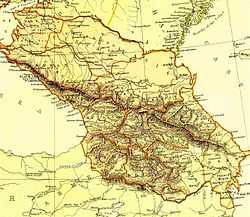Transcaucasian Democratic Federative Republic
| Transcaucasian Democratic Federative Republic | |||||
| Закавказская демократическая федеративная республика | |||||
| Federative republic | |||||
| |||||
|
| |||||
 Transcaucasia (South Caucasus) immediately prior to the formation of the Transcaucasian Democratic Federative Republic. | |||||
| Capital | Tbilisi | ||||
| Languages | Georgian Azerbaijani Armenian | ||||
| Government | Federative republic | ||||
| President | Nikolay Chkheidze | ||||
| Historical era | World War I | ||||
| - | Federation proclaimed | February 24, 1918 | |||
| - | Georgia declares independence | May 26, 1918 | |||
| - | Armenia and Azerbaijan declare independence | May 28, 1918 | |||
| - | Federation dissolved | May 28, 1918 | |||
| Currency | Transcaucasian ruble | ||||
| Today part of | | ||||
The Transcaucasian Democratic Federative Republic (TDFR; Закавказская демократическая Федеративная Республика (ЗКДФР); Zakavkazskaya Demokraticheskaya Federativnaya Respublika (ZKDFR); February – May 1918), also known as the Transcaucasian Federation, was a short-lived South Caucasian state extending across what are now the modern-day countries of Armenia, Azerbaijan, and Georgia.
History
After the February Revolution, the Russian Provisional Government installed the Special Transcaucasian Committee (особый Закавказский Комитет (ОЗАКОМ), osobyy Zakavkazskiy Komitet (OZAKOM)) to govern the area.
Sejm

In November 1917, following the October Revolution, the first government of an independent Transcaucasia was created in Tbilisi. A Transcaucasian Committee and a Transcaucasian Commissariat (Sejm, headed by the Georgian pro-Menshevik Social Democrat Nikolay Chkheidze) existed for a couple of months. On December 5, 1917, the Committee endorsed the Armistice of Erzincan signed by the Ottoman command of the Third Army.
Transcaucasian Democratic Federative Republic
On February 10, 1918, the Sejm gathered and made the decision to establish independence. Two weeks later, on February 24, it proclaimed the establishment of the Transcaucasian Democratic Federative Republic.
On March 3, 1918, the Treaty of Brest-Litovsk marked the end of Russia's involvement in World War I. The Ottoman Empire regained Batum, Kars and Ardahan. Starting on March 14, the Trabzon peace conference was held between the Ottoman Empire and a delegation from the Sejm. By April 5, the head of the Transcaucasian delegation, Akaki Chkhenkeli, accepted the Treaty of Brest-Litovsk as a basis for more negotiations and urged the Transcaucasian governments to accept this position.[1] The mood in Tbilisi, however, was very different. A state of war between the Republic and the Ottoman Empire was confirmed[1] and, shortly afterwards, the Ottoman Third Army took Erzerum and Kars.
A new peace conference was convened at Batum on May 11.[2] The Ottoman Empire extended its demands to include Tiflis as well as Alexandropol and Echmiadzin, where their leaders wanted to build a railroad to connect Kars and Julfa with Baku. No agreement was reached and, on May 21, the Ottoman forces resumed their advance. The battles of Bash Abarn (May 21–24), Sardarapat (May 21–29) and Kara Killisse (May 24–28) followed.
On May 26, 1918, the Democratic Republic of Georgia declared independence, followed two days later by the Democratic Republic of Armenia and the Azerbaijan Democratic Republic. This marked the end of the Transcaucasian Democratic Federative Republic.
Military
Following the Russian Revolution, the breakup of the Russian Caucasus Army left the Caucasus virtually undefended against the advancing Ottoman Third Army. In response, the Armenians, Georgians and Azerbaijanis attempted to establish a unified military, placing their forces under the command of a "Military Council of Nationalities". These forces consisted of Armenian volunteer units formed during the course of World War I; Georgian forces raised by their Provisional Government; and Azerbaijani troops raised independently.
The Military Council of Nationalities was short-lived. On May 28, 1918, Georgia signed the Treaty of Poti with Germany and welcomed the German Caucasus Expedition as protection against post-Revolution instability and the Ottoman military advance.[3] Azerbaijan, on the other hand, chose to ally itself with the Ottoman Empire.
Legislature
- 32 Menshevik Social Democratic Labour Party members;
- 30 Musavat Party members;
- 27 Armenian Revolutionary Federation members, including Stepan Zorian ("Rosdom"), Hamo Ohanjanyan, H. Zavrian, Hovhannes Katchaznouni, S. Tigranian, Alexander Khatisian, K. Karchikian and M. Haroutiunian.
See also
- Transcaucasian SFSR
- Armenian–Azerbaijani War
- Georgian–Armenian War 1918
References
- ↑ 1.0 1.1 Richard Hovannisian, "The Armenian people from ancient to modern times", pages 292-293.
- ↑ Ezel Kural Shaw, History of the Ottoman Empire and Modern Turkey, page 326.
- ↑ Lang, David Marshall (1962). A Modern History of Georgia, London: Weidenfeld and Nicolson, p. 207-208.
